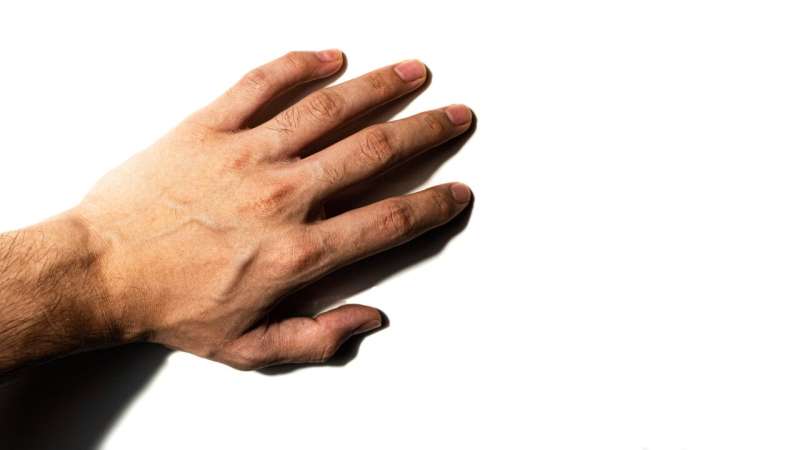New research reveals link between finger tapping and Alzheimer’s


Suddenly getting lost, failing to recognize family members, or forgetting words and names are well-known symptoms of Alzheimer’s disease. Psychologists have now discovered that the disease also manifests in more subtle ways: through the rhythm of finger tapping.
Neuropsychologists Vincent Koppelmans and Marit Ruitenberg conduct research on the relationship between the brain and movement and how various diseases influence both. “Many studies on Alzheimer’s primarily focus on cognitive symptoms like forgetfulness or major motor problems such as impaired balance. Vincent and I, however, found hints in the literature that there are also subtle differences in fine motor skills,” explains Ruitenberg.
Finger tapping tests
To further investigate this, they conducted computer tests on three groups of people: 47 healthy individuals, 27 people with Mild Cognitive Impairment (a possible precursor to Alzheimer’s), and 26 people with Alzheimer’s. Koppelmans explains, “They all performed a computer task that required them to tap their fingers in different ways. The instructions included tasks like ‘Tap your right index finger on the keyboard as quickly as possible within ten seconds.’ Then, follow with the left index finger, both fingers simultaneously, or alternating with both fingers.
“We analyzed how fast people tapped after the starting signal, how many taps occurred in a certain time frame, and the time intervals between taps.”
The aim: To discover if finger tapping can be a biomarker for Alzheimer’s. A biomarker is a measurable characteristic used to assess and monitor biological processes, such as diseases. “We wanted to investigate if finger tapping could be linked to other biomarkers to distinguish Alzheimer’s, for example, a shrinking hippocampus. We also looked at performance differences between different groups,” says Koppelmans. They used machine learning to examine if a computer could correctly classify participants into the right groups based on their finger-tapping patterns.

Slower tapping with Alzheimer’s
After analysis, they discovered that individuals with Alzheimer’s had slower reaction times and tapped more slowly and irregularly than the other groups. Individuals with MCI also performed less well on the tests. Koppelmans explains, “Tapping behavior, including how fast you tap and the variability in between, is impaired in individuals with Alzheimer’s or MCI, a potential precursor to Alzheimer’s.”
Additionally, the researchers found a consistent relationship between finger tapping and the size of the hippocampus, a brain area crucial for memory. People with a smaller hippocampus also scored lower on the tests. Koppelmans concludes, “This shows that finger tapping could potentially serve as a biomarker for Alzheimer’s.”
Finally, based on an individual’s tapping behavior, the computer was able to correctly predict the group to which they belonged in 70% of cases, although accuracy was lower for people with MCI. Ruitenberg says, “This suggests that the test could be a contender for future diagnostics.”
Early screening
What does this mean for the future? Will computers be able to diagnose Alzheimer’s in people based on their finger-tapping patterns? According to the researchers, it’s not quite that simple. However, they see the finger-tapping test as a valuable addition to existing research methods, especially when combined with the examination of other symptoms such as memory loss.
Koppelmans states, “Existing diagnostic tests for Alzheimer’s work very well. Doctors use PET scans to measure the presence of specific proteins in the brain, and MRI scans measure the size of the hippocampus. These are two strong indicators of Alzheimer’s. But these methods are expensive and somewhat invasive.”
Finger-tapping tests are more cost-effective, accessible, and less intrusive. “You could easily administer these tests in a primary care setting as part of early screening. If someone performs poorly on the test and also exhibits other symptoms indicative of Alzheimer’s, they could be referred for neuropsychological testing and possibly a PET scan.”
Toward improved diagnostics
The paper, “Delayed and More Variable Unimanual and Bimanual Finger Tapping in Alzheimer’s Disease: Associations with Biomarkers and Applications for Classification,” will be published this month in the Journal of Alzheimer’s Disease. It is part of a broader research effort examining the relationship between the brain, movement, and disease.
Ruitenberg explains, “We are studying a large group of people and a wide range of motor functions. Based on this, we aim to use machine learning to create profiles of different disease states, ultimately leading to improved diagnostics.”
More information:
Vincent Koppelmans et al, Delayed and More Variable Unimanual and Bimanual Finger Tapping in Alzheimer’s Disease: Associations with Biomarkers and Applications for Classification, Journal of Alzheimer’s Disease (2023). DOI: 10.3233/JAD-221297
Journal information:
Journal of Alzheimer’s Disease
Source: Read Full Article




